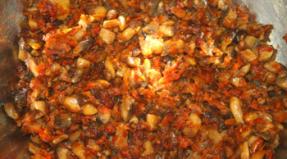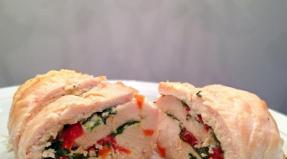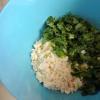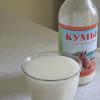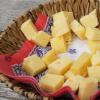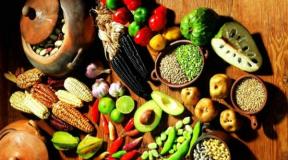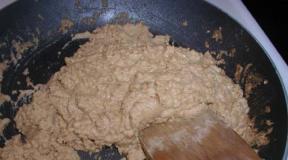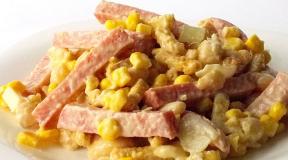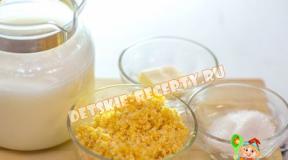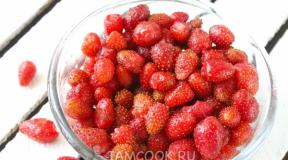Fresh cauliflower puree for babies: a delicious recipe. Cauliflower puree for babies - a recipe for tasty and healthy complementary foods
Hello Lyudmila!
My daughter will be 6 months next week and will need to introduce complementary foods. The pediatrician recommended that we start either with vegetables or with porridge. But since my baby is gaining weight so well, I'm more inclined towards vegetables.
Is it possible to start complementary foods with cauliflower?
Thanks for the question. Indeed, it is very good to start with vegetables, and complementary cauliflower can be the best way to introduce your baby to a new food.
At 6 months, the baby's gastrointestinal tract matures and the baby begins to show signs of readiness for complementary foods. I already talked about them in another article.
But so far we are not talking about large volumes, but only about introducing the baby to other foods. There is no need to overload the child's gastrointestinal tract and focus on the norms that are given in the children's clinic.
Why choose cauliflower
Cauliflower for children and adults is very useful. It is rich in fatty acids, vitamins and elements (micro and macro). Cauliflower is low in calories. It has the following effect on the body:
- does not cause allergies;
- improves digestion;
- increases the level of hemoglobin, due to the high content of iron;
- protein (vegetable) improves liver function;
- normalizes metabolic processes;
- improves the condition of bone tissue;
- strengthens blood vessels.
But, even with all its usefulness, the beginning of complementary foods with cauliflower is introduced strictly according to the rules and carefully.
When to Use Cabbage as a Feed
The best food for a baby is mother's milk. Therefore, the question often arises: from how many months can a child have cauliflower and how to introduce cauliflower into complementary foods? When breastfeeding, complementary foods can be started from 5.5 to 6.5 months.
Mom's milk still copes with all the needs of the child's body, so there is no need to worry that the child will not receive any useful substances. Don't rush into feeding.
- For the first feeding, vegetables that grow traditionally in your area are suitable, not bright;
- You can start with mashed potatoes of the required consistency or give your child a microdose of boiled cauliflower;
- A microdose is a small piece, about the size of a grain of rice;
- The child will try a new taste, try to swallow;
- Food will enter the stomach and cause the production of the necessary enzymes for digestion;
- If you give the child food in a piece, then you will see that it will come out undigested. However, it also happens with mashed potatoes, simply, because of the liquid consistency, you will not see this in the baby's stool.
What does this tell us? The gastrointestinal tract is only training and the child is not ready to take large amounts of food.
- In season, it is advisable to puree fresh cauliflower. It is quite possible to do self-cooking:
- First you need to use puree from one vegetable;
- After, by seven months, prepare a combined vegetable puree in which you will be completely sure.
- If the input period falls in the winter: canned food or frozen vegetable preparation is used. I’ll tell you a little lower about how to freeze cabbage for feeding your baby.
Jars are convenient on the road or when force majeure occurs in the house. In this case, canned food helps a lot.
By the way! I would not recommend constantly feeding a child with jarred products, because nothing compares to freshly prepared mashed potatoes from properly selected products.
If you have so far chosen to introduce cabbage in the form of mashed potatoes, then grinding to the required consistency is done using a blender.
Introduction rules
Cauliflower for children up to a year, like other products, has some introduction rules so that the process of eating for your baby becomes an interesting and joyful event.
- The child eats with the mother. He will have an interest in food, which is extremely important for the development of the desire to eat and the taste preferences of the baby;
In the end, he is interested in eating in his mother's arms. This is your close contact, the child learns from you the culture of eating.
- New components in the diet are introduced after 1-2 days, if the baby has a tendency to allergies - after 3-5 days or a week. This is done so that it is easy to identify the food product to which an allergic reaction has occurred;
If you give everything and a lot, you will not understand what caused the deterioration.
- The volume of consumption is completely individual. It is important to look at the child and build on his abilities, age and desires;
- The first couple of months there is an acquaintance with nutrition, do not force the baby to eat, let your baby show interest on his own. Stuffing in the mouth will discourage all the hunting and joy from eating;
- Complementary foods are in no way a substitute for breastfeeding. These 2 processes run in parallel!
- Microdoses of acceptable products can be given for review.
Types of complementary foods: pediatric and pedagogical
Pedagogical
This is a new approach to getting to know adult food, developing an interest in new tastes and eating on your own.
In the pediatric case, everything is calculated according to the plan: time, volume, type. When pedagogical, there are no strict rules - you feel your baby.
- The main difference is that food is not cooked separately. Your diet mainly consists of foods that are allowed for the baby. For example: soup without sautéing and roasting, without fatty meats, etc.;
- The child, together with his parents, tries "adult" food in microdoses. You can't force a baby to eat. He just gets acquainted, the main food is mother's milk;
- With pedagogical complementary foods, with age, you do not need to chop food. When the baby can chew, he gets acquainted with solid food, while learning to swallow;
- At the age of five months, the reflex of pushing out the tongue (spitting) disappears. The baby can already sit down, chew and digest food;
- First, he sits in his mother's arms. After trying one product, you need to take a break for a couple of days to see the negative reaction if it appears;
- Over time, the number of microdoses increases. The baby can already sit on his own place (high chair) and use his own plate.
It is a great joy for him: to do what mom and dad do! Breastfeeding doesn't stop.
- The main task of pedagogical complementary foods is the gradual adaptation to adult food, to its texture and taste. By the age of one year, the volume of food reaches several spoons.
What should I pay attention to with this type of complementary foods?
- Your child's condition;
- The presence of allergic reactions;
- The health of parents or other family members from whose plate the baby eats;
- Eating healthy foods. The parental diet should consist of products allowed for a small family member;
- It is not allowed to get on the eyes of products prohibited for the baby (smoked meats, sweets, etc.).
Pediatric
- The child eats separately prepared food of a special consistency separately from family members;
- Breastfeedings are not replaced abruptly, there is supplementary feeding after complementary feeding.
Important! The child is not entertained or forced to eat.
As it was before: a theatrical performance was arranged and everything that needed to be eaten was pushed in.
In this case, there is a danger that the child will eat only for entertainment or a hatred of food will be brought up. Remember, your baby has a feeling of hunger, appetite and a sense of regulation of these processes.
The best solution for complementary foods is to combine two options: food in the form of puree and food from mom's plate.
Rules for boiling and mashing
What is the best cauliflower for the first feeding and how to cook cauliflower for feeding?
Do not worry, the main thing is to choose a good quality product and cook it with the maximum preservation of all useful substances.
- When buying cabbage, pay attention to its appearance. It should be white, without dark spots, the leaves are green, dense and adjacent to each other. The forks are dense, the inflorescences are pressed;
If it is decided to use cauliflower for the first feeding, a number of questions always arise:
How to cook cauliflower for the first feeding? How much to cook cauliflower for feeding.
To make puree you need:
- rinse the cabbage forks;
- soak for 10 minutes in salt water, this will get rid of harmful components if the cabbage is bought and not grown on its own;
- dry it;
- divide into parts of the inflorescence;
- cook in a double boiler or boil. Cook for 10 minutes fresh, 15 - frozen);
- it is recommended to throw it into a boiling liquid, so there is a minimal loss of vitamins;
- further - the grinding process: with a blender or with a sieve;
- if there is not enough liquid, add broth or boiled water.
How to freeze to save maximum utility
When freezing, it is necessary to follow quite simple rules and your baby will be provided with a full-fledged healthy cauliflower for the winter.
- you need to choose a dense head of cabbage, without spots;
- separate the leaves and divide into inflorescences (so easy to store);
- soak in salt water and soak for about ten minutes;
- Rinse;
- soak in boiling water for three minutes;
- dry (you can not freeze wet vegetables);
- divide in portions into one preparation;
- such cabbage is stored for about nine months.
How much to give and when
You can come across the opinion that cabbage should be given only to an 8-9 month old baby, because of its ability to increase gas formation, or it can cause constipation.
Know! In practice, nothing of the kind, with the correct and timely introduction of cabbage into complementary foods, was noticed.
Like all products, the start of complementary foods with cauliflower should be organized gradually: half a teaspoon and brought to the volume that the child, due to his age, can eat.
Remember! The child only gets acquainted with the tastes and the portions are still small. The main food remains - breast milk.
After, when the baby grows up, the nutrition with vegetable soups and other types of complementary foods becomes complete, and the nutrition with milk is additional.
Have you given your baby cauliflower yet? Or are you just going to do it? Share in the comments.
Vegetables for the first feeding of the baby. The timing of the introduction of vegetables in the diet of the child.
The main function of the first complementary foods for a baby is to enrich the growing body with reserves of vitamins and minerals. The choice of vegetables for the first feeding should be discussed with your pediatrician and selected individually for each.
Cauliflower puree
Cauliflower is ideal for the first feeding, due to its easy digestibility and the presence of a wide range of vitamins and minerals. Thanks to fiber, cabbage has a beneficial effect on the digestion of the child.
Cauliflower contains contains the following useful components:
- vitamin C
- carotene
- potassium
- magnesium
- phosphorus
- easily digestible proteins
- rich in amino acids
- mineral salts
- carbohydrates
- B vitamins

 Child eating cauliflower puree
Child eating cauliflower puree - Cauliflower has invaluable benefits at the first feeding if the baby suffers from constipation and increased gas formation.
- If the baby is allergic, cabbage will help relieve all the symptoms of food allergies and reduce the location of the rash
- In addition, the use of cabbage for complementary foods prevents iron deficiency anemia.
- Phosphorus and minerals in cabbage have a beneficial effect on the functioning of the liver and gallbladder
- Physicians evaluate the beneficial effects of such complementary foods through normalization blood composition in a baby, strengthening the walls of blood vessels and bones
At what age can a child eat cauliflower?
The age at which it is recommended to start complementary foods with cauliflower ranges from four to six months. And regardless of whether the baby was breastfed or bottle-fed, you should discuss the timing of complementary foods with a pediatrician or nutritionist.
Breastfed babies have a better prepared enzymatic system than formula-fed babies.
Also, it all depends on the individual characteristics of the baby's body.
If the child is overweight, he is strongly advised to introduce vegetable purees into complementary foods, and children who are underweight are likely to be advised to feed cereals for as long as possible.

 Cauliflower
Cauliflower The introduction of cauliflower into complementary foods should be carried out according to the developed scheme.
- The first feeding should be no more than ½ teaspoon.
- Then observe the reaction of the child and his body. The first sign that the baby is psychologically ready to eat heavy food will be the absence of food being pushed out of the mouth with the tongue. Further, the child's stool should not have a pungent odor and mucus.
- Within ten days, you can gradually increase the dose of complementary foods to 100 grams.
The transition to adult nutrition should be gradual and starting with one product.
How to prepare cauliflower puree for a baby for the first feeding?
To prepare mashed cauliflower for the first feeding, first select and buy clean and fresh cabbage without stains. It is advisable to always purchase fresh cabbage, and only as a last resort frozen. The freezing process takes away the bulk of vitamins and minerals from vegetables.
Pay attention to the main characteristic features of the appearance of cabbage:
- cabbage color should be ivory
- leaves are bright green and clean
- there should be no darkening and defects
- the cabbage itself is elastic, and the inflorescences are densely planted
It should be remembered that canned complementary foods are in many ways inferior to freshly prepared vegetable puree.
- To prepare vegetable puree, thoroughly rinse the products under running warm water.
- Brush the vegetables as needed.
- Separate the inflorescences for cooking
- The cooking process is carried out in pre-boiling water
- Salt is better not to add
- After cooking, cauliflower is crushed with a blender or rubbed through a sieve.
- The consistency of the finished puree should resemble kefir in density. Not thicker, as the child may refuse to try a serving of complementary foods.
- If the puree is very thick, dilute it with breast milk or cabbage broth.
A serving of mashed cauliflower should only be freshly cooked. Do not use pre-prepared foods. Pathogens can develop in such a product, and repeated heating will kill any remaining beneficial substances.
How much to cook fresh and frozen cauliflower for baby puree?
The main goal of heat treatment of products for a baby is the desire to make it easily digestible and to preserve the nutritional and vitamin value to the maximum.
- Therefore, cooking should take place according to a strictly defined time for each vegetable. Too long cooking will lead to the complete destruction of the vitamin cocktail, and insufficient cooking will increase the risk of transmission of various infections through the product.
- Cooking time for fresh cauliflower is 10-15 minutes in boiling water.
Cooking time for frozen cabbage varies between 15-20 minutes after boiling water. - During cooking, do not cover the cooking container with a lid, so as not to get a nice yellow tint. It is advisable to choose only an enameled cooking pot.
- After the vegetable is fully cooked, it should be laid out and not kept in water.
If you cook cauliflower for baby puree in a multi-steam cooker, then its cooking time will be 30 minutes.
Frozen cauliflower puree for babies
If your baby's feeding time is not during cauliflower season, you can pre-freeze the vegetable for further puréeing. This process can be done with two processes, raw and after blanching the cauliflower.
If you decide to freeze fresh cabbage, then thoroughly rinse the vegetable inflorescences and lower them additionally in hot water with salt for twenty minutes. Pat the cabbage dry and pack into freezer bags.
If you choose cabbage blanching, then carefully washed cabbage should be dipped in boiling water for five minutes. Next, dip in cold water, dry and place in containers for freezing.
A useful set of the most important trace elements of cabbage is stored for a long time in the freezer, and therefore at any time you can enter the product into the child's menu.
Video: Cooking frozen cauliflower puree for babies
At what age can mashed potatoes and cauliflower be used for babies?
After the first vegetable complementary foods have been introduced, the menu can begin to use several vegetables in one puree.
Potatoes can be introduced into the baby's diet in the seventh month of life. It is an easily digestible vegetable and contains a large amount of fiber, which does not irritate the stomach and is very beneficial for intestinal peristalsis.

 Vegetable mix for babies
Vegetable mix for babies Complementary feeding of mashed potatoes and cauliflower can be started even during the baby’s breakfast, as its carbohydrates are a quickly digestible product and will not cause unnecessary discomfort.
Mixed mashed potatoes should take up no more than half of the total volume.
The proportions of potatoes in such a puree increase during the week by 2-3 teaspoons.
Mashed potatoes and cauliflower for a child: a recipe
Mashed potatoes and cauliflower can be given to the baby for breakfast and lunch.
For the preparation of complementary foods we take:
- one medium sized potato
- about a hundred grams of cauliflower
- 80 grams of breast milk.
Cooking:
- Boil potatoes for no more than 15 minutes
- Add cauliflower and bring to a boil
- We wipe the cooked vegetables through a sieve. Pour breast milk into puree, cool
Video: Baby puree recipe with potatoes, carrots and cauliflower
From what age can pumpkin and cauliflower puree be used for babies?
Pumpkin has a rich vitamin composition. It contains proteins, carbohydrates, fiber, vegetable oils, potassium, calcium, iron. It has a sweetish taste, which is sure to please the baby.
The first acquaintance of a baby with a pumpkin can be started with a two-component puree pumpkin and cauliflower.
Feeding time with such a sunny vegetable should begin no earlier than seven months.

 Baby puree with pumpkin
Baby puree with pumpkin Pumpkin and cauliflower puree
To prepare pumpkin and cauliflower puree, we take:
- Small piece of pumpkin 100 gr
- 100 gr cauliflower florets
- 50 grams of breast or goat milk
Cooking:
- Cut pumpkin into small cubes
- Simmer over low heat, in a small amount of water. We bring to readiness - softening
- We wipe the vegetable through a sieve
- Cook cauliflower in boiling water for no more than ten minutes until soft.
- Beat pumpkin with cauliflower in a blender, combine with warm breast milk
- Boil a few minutes
- Cool down and feed the baby
At what age can I have cauliflower and carrot soup for babies?
Carrots are a very useful and necessary vegetable for feeding a baby. It has a bactericidal effect and will help restore the child's body after infectious diseases. The vegetable contains carotene and calcium, useful for baby macro- and micronutrients.
The time for the introduction of complementary foods in the form of soups - mashed potatoes with carrots for babies is not earlier than 9-10 months.
Cauliflower and carrot soup for babies
In the video below you can see a simple recipe for instant soup puree and carrots.
Video: Cauliflower and Carrot Puree Soup
Cauliflower has recently become more and more popular among housewives. Dishes from it are tasty, healthy and allow you to diversify the diet. One of the easiest to prepare and healthy dishes from it is mashed potatoes.

vegetable properties
The main ingredient in puree is cauliflower. First of all, it is important to understand what is the use of this wonderful product. Cauliflower, like any other variety of cabbage, contains a large amount of nutrients that help improve our health.

Cauliflower contains almost the entire range of vitamins:
- vitamin A promotes the growth of the body, helps improve vision;
- vitamin K helps the absorption of calcium and vitamin D in the body;
- biotin promotes collagen production;
- folic acid promotes active cell growth, activates the immune system, and also prevents the appearance of neoplasms;
- choline lowers cholesterol levels, optimizes cardiac activity;
- vitamin C is a natural antioxidant, one of the most important and necessary vitamins for a person, which helps to strengthen the immune system, is indispensable for the prevention of various diseases.



An important point: all cabbage vegetables are leaders in the amount of vitamin C content. It is generally accepted that all types of citrus fruits contain the largest amount of vitamin C. But science says otherwise. 100 g of cabbage contains twice as much vitamin C as the same amount of lemon.
In addition to these vitamins, cauliflower also contains a large number of trace elements: zinc, copper, iron, selenium, potassium, calcium, phosphorus and magnesium.


We list the beneficial properties of cauliflower:
- easily absorbed by the body;
- improves bowel function and normalizes stool without contributing to flatulence;
- saturates us with vitamins and microelements and, as a result, there is more energy and vivacity;
- cleanses the body and removes dangerous toxins;
- cauliflower is useful for the growth and development of nerve cells;
- a large amount of iron is used to prevent anemia;
- beneficial substances contained in cabbage help strengthen the vessels of the heart, relieve inflammation;
- prevents the development of cancer.


Cauliflower puree can be consumed by absolutely everyone: men and women, adults and children. Leading pediatricians recommend cauliflower puree for the first feeding for babies from 6 months, and for babies who are on artificial feeding, from 4 months. It almost does not cause allergies and contributes to the proper functioning of the baby's intestines, which is proof of the usefulness of the dish.
The main thing is to know how many calories are in the product. For example, 100 grams of cauliflower contains only 33 kilocalories. Of these: proteins - 1.6 grams, fat - 0.7 grams, and 5.4 grams of carbohydrates. That is why cauliflower puree is recommended for dietary nutrition. People who adhere to proper nutrition (PP) also need to include this dish in their daily menu.
All these beneficial properties prove that cauliflower should be a must in your diet.


Selection and preparation of ingredients
The preparation of any dish begins with the right selection of ingredients.
Consider what to look for when buying cauliflower.
- The appearance of the head. It should be firm, resilient, with leaves tightly adjacent to each other, without voids or damage. The leaves should be free of dirt and any plaque. These are all signs that the product has begun to deteriorate.
- Appearance of cabbage inflorescences. Inflorescences should be dense, white. A slight yellowish tint is allowed. Sometimes in stores you can see cauliflower with bright green buds. Don't be scared. Some varieties have inflorescences of this color, but they are quite rare. In addition, the inflorescences must be free of mechanical damage. Damaged inflorescences indicate that there were gross violations in the rules for storing or transporting the product. And this directly affects the quality. The presence of young leaves between the inflorescences is one of the signs of a good quality product. Such leaves protect the inflorescences from drying out, thereby contributing to the preservation of useful substances in them.
- Product weight. The lighter heads are usually grown in greenhouses using a lot of chemicals. This allows you to get large yields and accelerate the output of products. But chemicals cause irreparable harm to our health.
- In addition, in any variety of cauliflower there should be no pests.
Please note: for making cauliflower puree, you can also opt for quick-frozen cabbage. In stores there is always a large selection of such products from different manufacturers. Using such a product will save you time searching for the right ingredients.



What is combined with?
Just like regular mashed potatoes, cauliflower puree goes well with cream and butter. Each of these ingredients will not only improve the taste of your dish, but also bring more nutrients to it.
- Cream is very useful because it contains calcium. And in them it is twice as much as in milk. In addition, they contain easily digestible proteins, carbohydrates and many vitamins and minerals.
- Butter is rich in vitamin A, E and B vitamins. Unlike vegetable oils, butter contains healthy saturated fats and omega-6 acids. They improve digestion.


How to cook?
Cauliflower puree
One of the easiest cauliflower puree recipes, suitable even for feeding babies, can be prepared very simply.
Composition:
- cauliflower - 1 head;
- pasteurized milk - 0.5 cups;
- butter - 2 tablespoons;
- salt to taste.
Before cooking, the cabbage is disassembled into inflorescences. Then you need to thoroughly rinse them and pour lightly salted water for half an hour. This will get rid of insects that may be in the cabbage.



If you intend to use frozen cabbage, then you should not wash it. In addition, it can be put for 30-40 minutes in salted water without defrosting immediately. This will not harm the taste of the dish, and will not affect the cooking process.
- Boil water in an enamel saucepan. To prevent the loss of a large amount of vitamin C, which is contained in cabbage, aluminum dishes should not be used for cooking.
- Immerse the inflorescences disassembled and pre-soaked in salted water in boiling water (make sure that the water covers the inflorescences completely) and close the lid. Cooking time is selected depending on what kind of cabbage you use. Usually boil it for 7 to 15 minutes. When cooking, they are guided by the softness of the inflorescences. It is always better to undercook than to overcook. Overcooked inflorescences will turn into porridge during cooking.
- Important: the broth obtained by cooking the vegetable should not be drained. It can come in handy for making purees and can also be used as a base for vegetable soups.
- Remove the boiled inflorescences, cool and grind with a blender. In the resulting mass, add warm milk, butter and a pinch of salt. Pass through the blender again.
If you are cooking for a baby or have a healthy diet, you should be careful when using table salt. Too much salt is bad for health. Ideally, salt can be omitted from the finished cauliflower puree. Milk can also be replaced with low-fat cream.


Cauliflower puree with cottage cheese
Cottage cheese will not only enrich your puree with calcium, but also increase its calorie content. For cooking, it is best to use low-fat cottage cheese (from 2 to 5%).
Products:
- 0.5 kg of cauliflower;
- 50 g fat-free cottage cheese;
- 0.5 l of milk;
- 1 egg;
- 1 teaspoon turmeric;
- a pinch of salt (pepper).



Cooking:
- rinse, disassemble cabbage into inflorescences and place on the bottom of the pan;
- pour the prepared inflorescences with milk and cook over low heat until soft for about 15-20 minutes (until the amount of milk is reduced by half), then turn off the heat;
- using a blender, turn the cabbage into mashed potatoes right in the pan;
- prepare the eggs by separating the yolks from the proteins, add the yolks, turmeric and cottage cheese to the puree;
- salt and add pepper (optional);
- Stir the contents of the pan and put back on the fire, stirring constantly, cook over low heat until thickened (about 5 minutes).
Garnish with a sprig of parsley, dill, lettuce or spinach when serving. It is not only beautiful, but also useful.

Cauliflower puree with melted cheese
Products:
- 0.7 kg of cauliflower;
- 1 bulb of onion;
- 2 processed cheese (preferably the best quality);
- 2 cloves of garlic;
- salt, pepper to taste;
- some olive oil.
If the finished puree is supposed to be used in baby food, garlic and pepper can be excluded.



Cooking:
- disassemble the cabbage into inflorescences and boil in salted water until soft (remember, if you use frozen cabbage, then it should be lowered into boiling water);
- finely chop the onion, grate the garlic or mash with a press;
- fry the onion in olive oil until golden brown;
- mix still warm boiled cabbage with fried onions and garlic, add melted cheese, salt, pepper and, using a blender, turn it into mashed potatoes.
The finished puree should be airy and should not contain any lumps. Put the dish on a plate and decorate with any fresh herbs.

Diet cauliflower puree
You can add various spices if you wish. But the more spices, the stronger the appetite, which means the more you eat.

Introduction to feeding children up to a year of cauliflower should be done gradually.
- Cauliflower is usually given to a baby after squash at 6 months of age.
- The vegetable can be given along with cereals without milk (corn, rice or buckwheat). This will enable you to gain weight more quickly.
- The quantity is just as important. You need to start complementary foods with just one teaspoon, preferably in the morning.
- At the beginning of complementary foods, you need to carefully monitor the baby and his reaction. If allergy symptoms appear, you should immediately stop taking the vegetable and contact your pediatrician immediately!
- If there is no allergy, gradually increase the dose of puree. By seven months, you can already give 150 grams, and by the year the amount can be increased to 200 grams.
- The product for the child should be prepared immediately before use. This will eliminate the risk of intestinal disorders, and such puree will be more beneficial for the baby.


The recipes presented in the article prove that you can make the most diverse and delicious mashed potatoes from cauliflower. It will be not only an independent dish, but will also be an excellent side dish for main courses.
If you wish, you can improve the quality of the finished dish if you use cauliflower that you have prepared yourself since autumn as ingredients. Then you will be sure of the absolute safety of the product.

See the following video for how to make cauliflower puree.
The traditions of the introduction of complementary foods are different everywhere. In the CIS countries, vegetables, milk porridges and fermented milk products compete for the palm.
But the choice should be based not only on the opinion of the mother, but also on the state of health of the baby:
- With bloating and diarrhea, complementary foods begin with cereals.
- With intestinal colic and constipation, exceeding the age norm in terms of body weight, vegetables are chosen.
You need to start with what is grown in your area.
Give preference to white or green vegetables: they contain non-coarse, easily digestible fiber.
Choose hypoallergenic crops, even if the toddler does not have a tendency to allergies - it will be easier for an immature digestive tract to cope with them.
With a competent start of the first vegetable complementary foods, the child does not face unpleasant consequences. In the future, this will help the baby adapt to any solid food: from squash puree to meat.
Why pediatricians choose cauliflower:
- rarely causes allergies;
- pleasant to the taste;
- easily digestible;
- contains less fiber compared to white cabbage: lower risk of bloating;
- the composition includes minerals: phosphorus, potassium, iodine, magnesium, iron and cobalt;
- rich in vitamins A and C (three times more than white varieties), B, E, K, H, PP - compounds that make the baby's body more resistant to viruses and have a beneficial effect on its health in general;
- contains easily digestible vegetable proteins necessary for the functioning of the liver and gallbladder and the full development of the child;
- strengthens bones;
- improves metabolism;
- increases the strength and elasticity of the vascular walls;
- useful for babies with high blood sugar.
Minuses
It will take a lot of effort from mom to prepare such complementary foods. After all, cabbage inflorescences are not easy to wash. This is partly why home-made multi-component vegetable purees, which include not only cauliflower, are popular among parents.
Own food or store?
Ready canned food means a minimum of hassle. WHO experts advise him, referring to a balanced composition that is difficult to reproduce at home.
It is important to check the expiration date and tightness of the container. And look at the ingredients: there should be only water and vegetables. The presence of starch, milk, maltodextrin, salt and spices indicates low quality.
An opened jar is a fertile environment for harmful microbes. Therefore, experts recommend feeding the baby puree from a jar only once: immediately after opening. The product is not suitable for repeated use.
So that baby food does not undermine the family budget, use a compromise option: put a little puree from the jar with a clean spoon on a plate or in a cup, then close the container tightly with a lid and send it to the refrigerator, but not more than for a day.
Cooking puree at home
There are parents who accept only homemade complementary foods. Indeed, homemade food has advantages: a mother can not worry about the quality and each time cook exactly as much as needed.
You can buy fresh or frozen cauliflower. In the second case, pay attention to the amount of ice and the specified shelf life. There are fewer vitamins in the frozen product, so use fresh vegetables whenever possible.
- Choose ivory pieces that are free of black spots and other visible damage.
- Tear off small inflorescences from a head of cabbage, leave for 20 minutes in water to get rid of possible insects. Before preparing complementary foods, it is recommended to leave purchased cabbage in cool boiled water for 4 hours: during this time, pesticides and other harmful substances will leave it.
- Rinse the inflorescences thoroughly and brush with a brush under running water, then disassemble into components.
- Throw in boiling water and cook for 7-10 minutes, preferably in an enamel bowl. Salt is not needed.
- Grind in a blender or with a fork, followed by rubbing through a special food strainer.
- The consistency should be something like that of kefir, otherwise the child may refuse complementary foods. Bring the finished puree to the required density with vegetable broth or breast milk. Infant formula is also an option.
Prepare a new portion for each meal.
Cooking mashed potatoes in a slow cooker will take 25 minutes, in a double boiler - at least 15 minutes with the right mode, in a microwave oven - 7-10 minutes, depending on the power.
When and how to enter?
Usually, the introduction of cauliflower does not become a problem, especially if the mother is breastfeeding the baby, who herself eats this vegetable from time to time. Such babies can get acquainted with a vegetable as early as 6 months.
Formula-fed babies are allowed to do this even earlier - at 4-5 months.
Until the indicated age, it is not necessary to introduce cabbage: the stomach of the crumbs will not be able to cope with it.
It is best to give complementary foods in the morning or at lunch, starting with half or a whole teaspoon. That in the time remaining until the evening to follow the reaction of the body. But even if everything is fine, on the same day, the baby is no longer offered mashed potatoes. The next day, and preferably in a couple of days, the portion is increased by half a teaspoon. So in a month they reach 50 g per day.
If cauliflower puree has already been on the menu for a month, it is allowed to enrich it with a drop of unrefined vegetable oil.
Most babies do not have allergies after the introduction of complementary foods with cauliflower. But in the first days and months of the formation of a new menu, a pediatrician should look after the baby.
Cauliflower is ideal for feeding children, because it does not contain coarse fibers that irritate the gastric mucosa. Enough vitamins and minerals. And although when processing cauliflower, under temperature, many vitamins evaporate, easily digestible protein remains. It is very necessary for the baby for growth and development.
How to cook cauliflower for babies - recipe with photo:
 1. Cabbage is better to take fresh. But if for some reason it is not possible to purchase it, frozen will do.
1. Cabbage is better to take fresh. But if for some reason it is not possible to purchase it, frozen will do.
The oil must be cold pressed. It has more utility. For children, olive or linseed oil is suitable. They are useful and freely sold in many stores. But if possible, you can also use other healthy oils, alternating them. It can be macadamia oil, corn, cedar, almond or nut oils.
 2. We wash the required portion of cauliflower well under the tap and cut it into inflorescences. For a small child under 1 year old, we will steam the cabbage.
2. We wash the required portion of cauliflower well under the tap and cut it into inflorescences. For a small child under 1 year old, we will steam the cabbage.
